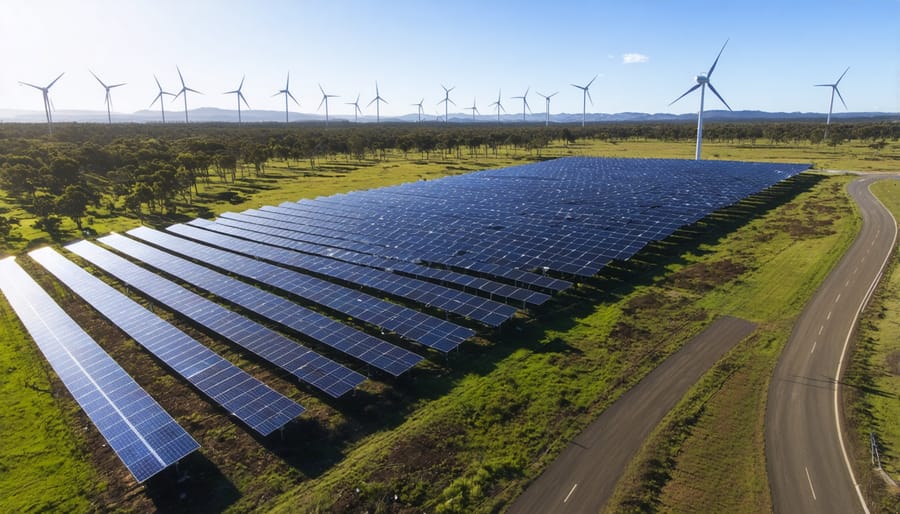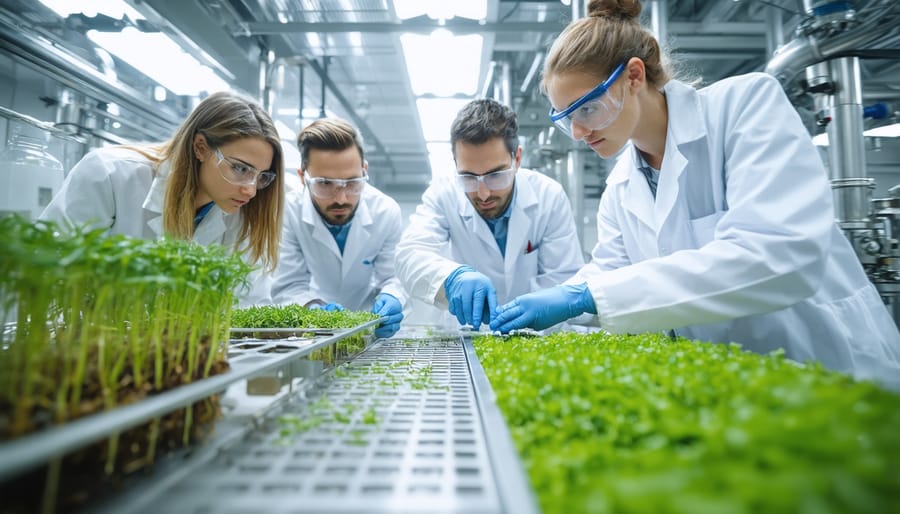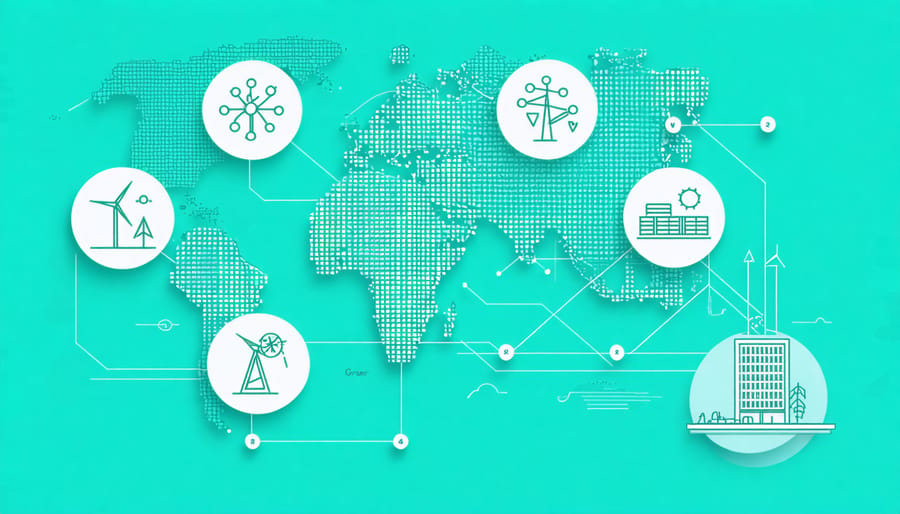In the face of escalating global environmental challenges, international cooperation has emerged as our most powerful tool for driving meaningful climate action. From the groundbreaking Paris Agreement to innovative cross-border renewable energy projects, nations are increasingly recognizing that environmental threats transcend political boundaries and demand unified solutions.
Australia’s unique position in the Asia-Pacific region exemplifies how international partnerships can accelerate sustainable development. Through strategic collaborations with neighboring countries, we’re witnessing unprecedented progress in sharing clean energy technologies, protecting shared marine ecosystems, and developing resilient climate adaptation strategies.
The success of these international environmental initiatives relies on three crucial elements: shared responsibility, technology transfer, and coordinated policy frameworks. Recent achievements, such as the International Solar Alliance and the Global Methane Pledge, demonstrate how collective action can rapidly scale up sustainable solutions and create lasting environmental impact.
As we navigate the critical decade ahead, strengthening these international bonds becomes more vital than ever. By pooling resources, expertise, and innovation capabilities across borders, we’re not just addressing environmental challenges – we’re creating a blueprint for sustainable prosperity that benefits all nations.

Building Bridges: Australia’s Role in Global Energy Partnerships
Key International Agreements
Australia has established itself as a key player in international environmental cooperation through several significant agreements and partnerships. The Paris Agreement stands as a cornerstone of Australia’s climate commitments, with the nation pledging to reduce emissions by 43% below 2005 levels by 2030. This commitment has catalyzed numerous bilateral partnerships, including the Australia-Germany Hydrogen Accord and the Japan-Australia Clean Energy Partnership.
The International Solar Alliance (ISA) has proven particularly valuable, enabling Australia to share its solar expertise while learning from global best practices. Through the Regional Comprehensive Economic Partnership (RCEP), Australia has strengthened its clean energy trade relationships with Asian neighbors, facilitating technology exchange and joint renewable energy projects.
Notable success stories include the ASEAN-Australia Strategic Partnership, which has led to collaborative research initiatives in sustainable energy and the development of cross-border power grids. The Clean Energy Finance Corporation’s international partnerships have also attracted significant foreign investment in Australian renewable projects, demonstrating the country’s growing influence in the global sustainable energy landscape.
These agreements have created a robust framework for continued cooperation, positioning Australia as both a leader and beneficiary in the international push toward sustainable energy solutions.
Cross-Border Technology Exchange
Australia’s commitment to international environmental cooperation has led to several groundbreaking technology exchange initiatives. A notable example is the Australia-Germany Hydrogen Innovation and Technology Incubator, which facilitates knowledge sharing in renewable hydrogen production and storage technologies. This partnership has already resulted in the successful implementation of pilot projects in both countries, demonstrating the power of cross-border collaboration.
The Australian Renewable Energy Agency (ARENA) has established successful partnerships with organizations in Japan and South Korea, focusing on advancing decentralized energy systems and smart grid technologies. These collaborations have enabled Australian communities to benefit from cutting-edge Asian innovations in battery storage while sharing our expertise in solar integration.
A particularly successful initiative has been the Pacific Climate Change Science Program, where Australian scientists work alongside Pacific Island nations to develop and implement climate-resilient technologies. This program has not only enhanced regional capacity for environmental monitoring but has also created a valuable knowledge-sharing network that continues to drive innovation in sustainable energy solutions throughout the Asia-Pacific region.
Bioenergy: A Shared Global Solution

Joint Research Initiatives
International research collaborations are driving innovative solutions in bioenergy development, with Australian institutions playing a pivotal role in several groundbreaking projects. The partnership between CSIRO and the Swedish Environmental Research Institute has yielded remarkable advances in converting agricultural waste into biofuel, demonstrating how cross-border expertise can accelerate sustainable energy solutions.
A notable success story is the Australia-Brazil Biomass Initiative, which has revolutionized approaches to rural power infrastructure through innovative sugarcane waste processing. This collaboration has resulted in a 40% increase in energy yield from biomass processing, benefiting both nations’ agricultural sectors.
The Pacific Bioenergy Research Network, connecting Australian scientists with partners across New Zealand and Pacific Island nations, focuses on developing marine-based biofuel sources. Their breakthrough research on algae-based biofuels has shown promising results for coastal communities, with pilot projects demonstrating commercial viability within five years.
These joint initiatives have not only advanced technical knowledge but also fostered knowledge sharing between communities. The Indigenous Knowledge Exchange Program, linking traditional Australian land management practices with international biomass production techniques, exemplifies how collaborative research can blend ancient wisdom with modern technology for sustainable outcomes.
Recent developments include the establishment of the Global Bioenergy Innovation Hub in Queensland, which brings together researchers from five continents to accelerate the commercialization of new bioenergy technologies.
Cross-Continental Supply Chains
Modern biomass supply chains stretch across continents, creating intricate networks that connect resource-rich regions with energy-hungry markets. Australia’s position in the Asia-Pacific region makes it a crucial hub for sustainable biomass trade, particularly in supplying wood pellets and agricultural residues to countries like Japan and South Korea.
These cross-continental partnerships are built on sophisticated logistics systems that ensure environmental sustainability throughout the supply chain. From the eucalyptus forests of Tasmania to the sugarcane fields of Queensland, carefully managed biomass resources are processed, transported, and utilized in ways that maximize efficiency while minimizing environmental impact.
The success of these networks relies heavily on international cooperation and standardization. Countries work together to establish certification systems, ensuring that biomass materials meet strict sustainability criteria. For instance, the partnership between Australian producers and Japanese power utilities has led to innovative tracking systems that verify the origin and sustainability of every shipment.
Maritime shipping routes play a vital role in these supply chains, with specialized vessels designed to transport biomass efficiently. Port facilities in Newcastle and Brisbane have adapted to handle these renewable cargo flows, installing purpose-built storage and handling systems that maintain product quality while reducing environmental footprint.
These international supply chains don’t just move materials – they transfer knowledge and technology. Through these partnerships, Australian expertise in sustainable forest management and agricultural practices is shared globally, contributing to worldwide efforts in renewable energy adoption.
Success Stories: International Collaboration in Action
The Asia-Pacific Connection
Australia’s partnerships with Asia-Pacific nations have yielded remarkable success stories in environmental cooperation. The Australia-Japan Clean Energy Initiative stands as a shining example, where both nations collaborate on hydrogen technology development and carbon capture solutions. This partnership has accelerated sustainable energy transitions across both countries while fostering innovation and knowledge sharing.
The Singapore-Australia Green Economy Agreement demonstrates another powerful collaboration, focusing on renewable energy trade and joint research initiatives. This partnership has already resulted in the development of several solar farms and enhanced grid connectivity between the nations, creating a model for regional cooperation.
In Indonesia, Australian expertise has helped establish community-based forest management programs that protect biodiversity while supporting local livelihoods. The initiative has successfully reduced deforestation rates by 30% in participating regions and created sustainable income streams for indigenous communities.
The Pacific Climate Partnership, involving Australia, New Zealand, and Pacific Island nations, showcases how regional cooperation can address shared environmental challenges. This alliance has implemented innovative coastal protection measures and renewable energy projects, helping vulnerable island communities build resilience against climate change while reducing their carbon footprint.
These partnerships highlight how cross-border collaboration can accelerate environmental progress and create lasting positive impact across the Asia-Pacific region.

European-Australian Initiatives
Australia and European nations have forged significant partnerships in renewable energy development, creating powerful synergies that accelerate the transition to sustainable energy solutions. The Denmark-Australia Green Energy Partnership stands as a prime example, leveraging Danish expertise in wind power to enhance Australia’s renewable energy capabilities. This collaboration has already resulted in the development of several offshore wind projects along Australia’s southern coastline.
Sweden and Australia’s joint initiative on sustainable forestry and bioenergy has revolutionized waste-to-energy practices, with Swedish technology being adapted for Australian conditions. The partnership has established three innovative biomass facilities in regional Victoria, converting agricultural waste into clean energy while supporting local farming communities.
Germany’s partnership with Australia through the German-Australian Hydrogen Innovation and Technology Incubator (HyGATE) demonstrates the power of international cooperation in advancing green hydrogen production. This initiative has attracted over $200 million in investment and established Australia as an emerging leader in renewable hydrogen technology.
The Netherlands and Australia have combined forces in marine energy innovation, focusing on wave and tidal power development in Tasmania. This collaboration has created a testing ground for new marine energy technologies while protecting delicate coastal ecosystems.
These European-Australian partnerships continue to expand, with new initiatives focusing on energy storage solutions, smart grid technology, and community-based renewable energy projects. The success of these collaborations serves as a model for future international environmental cooperation.
Future Pathways for Global Energy Cooperation
Emerging Partnership Opportunities
The landscape of international environmental cooperation is evolving rapidly, presenting exciting new opportunities for cross-border partnerships. As we continue transforming Australia’s energy landscape, emerging partnerships with Asia-Pacific nations are showing particular promise. Countries like Singapore and Japan are increasingly interested in Australia’s renewable energy expertise, especially in bioenergy production and sustainable agriculture practices.
One of the most promising developments is the Green Hydrogen Alliance, where Australian technology and abundant renewable resources are being matched with Asian manufacturing capabilities. This partnership model not only accelerates technological advancement but also creates sustainable economic opportunities for all participating nations.
The Pacific Islands Climate Partnership Initiative represents another innovative collaboration opportunity, focusing on sharing knowledge and resources in climate-resilient agriculture and renewable energy systems. Australian farmers and renewable energy experts are working alongside Pacific Island communities to develop sustainable solutions that can be adapted to various environmental conditions.
European partnerships are also opening new doors, particularly in the area of waste-to-energy technology transfer. Countries like Denmark and Germany are keen to share their advanced bioenergy expertise, while Australian innovation in agricultural waste management offers valuable insights for European partners.
These emerging partnerships are creating a ripple effect of positive change, fostering knowledge exchange, technological innovation, and economic growth. By leveraging our unique position as a renewable energy powerhouse, Australia is well-positioned to play a leading role in these international collaborations, helping to drive global environmental solutions while securing our own sustainable future.
Overcoming Common Challenges
Successful international environmental cooperation requires creative solutions to overcome common obstacles. One of the most effective strategies is establishing clear communication channels between participating nations through dedicated liaison offices and regular multilateral meetings. This approach has proven particularly successful in the Asia-Pacific region, where countries like Australia have taken leadership roles in facilitating dialogue and knowledge sharing.
Financial barriers often present significant challenges, but innovative funding mechanisms have emerged as viable solutions. The Green Climate Fund and similar initiatives demonstrate how burden-sharing arrangements can make sustainable energy projects more feasible for developing nations. Australia’s experience with the Clean Energy Finance Corporation shows how public-private partnerships can effectively bridge funding gaps.
Technical capacity differences between nations can be addressed through targeted training programs and technology transfer agreements. Success stories include mentorship programs where experienced nations provide expertise and support to emerging markets. The Australian Renewable Energy Agency’s international collaboration initiatives exemplify how knowledge-sharing platforms can accelerate sustainable energy adoption across borders.
Cultural and political differences need not be roadblocks to cooperation. By focusing on shared environmental goals and mutual benefits, countries can find common ground despite varying priorities. The key is developing flexible frameworks that accommodate different national circumstances while maintaining consistent environmental standards.
Data standardization and reporting mechanisms have also proven crucial for overcoming monitoring challenges. By adopting universal metrics and transparent reporting systems, countries can better track progress and maintain accountability in their joint environmental efforts. This approach has been particularly effective in measuring and verifying emissions reductions across international partnerships.
International environmental cooperation stands as our most powerful tool in addressing global climate challenges and advancing sustainable energy solutions. The success stories we’ve explored demonstrate that when nations work together, sharing knowledge, resources, and technologies, we achieve far more than any country could accomplish alone. From groundbreaking renewable energy partnerships to collaborative research initiatives, these joint efforts are accelerating our transition to a cleaner, more sustainable future.
Australia’s growing role in these international partnerships showcases the tremendous potential for local action to create global impact. By participating in multinational climate agreements and fostering bilateral relationships focused on sustainable development, we’re not just contributing to worldwide environmental goals – we’re securing our own future prosperity and environmental wellbeing.
The time for passive observation has passed. Whether you’re a business leader, policymaker, or concerned citizen, your support for international environmental initiatives matters more than ever. By engaging with these programs, advocating for stronger international cooperation, and implementing sustainable practices in your own sphere of influence, you become part of this global movement toward environmental sustainability.
Looking ahead, the success of our environmental efforts will depend on our ability to strengthen existing partnerships while forging new ones. Together, we can create a future where sustainable energy is not just an alternative, but the foundation of our global energy systems. The path forward is clear – through continued collaboration, innovation, and shared commitment, we can build a cleaner, more sustainable world for generations to come.

